The “public-ness” of public space is a loose concept. Public sidewalks are – in principle – meant to be accessible to and enjoyed by members of the public. That’s pretty simple. However, we are less likely to appreciate that the public right-of-way extends well beyond the edge of paved roads and sidewalks. A good portion of your front lawn is probably not exactly “yours”.
Municipalities put in place carefully-worded by-laws and regulations to minimize or prevent the obstruction or privatization of sidewalks. Yet, in a higher-density, inner-city commercial mainstreet environment, these rules seem to create as much tension as they resolve.
Public space is regularly used for commercial gain. For-profit places of business regularly “use” public property, both restricting its use to paying customers, as well as profiting from the use of property it does not own. At the same time, the result is often a lively animation of the street and a general enhancement of the overall street experience.
A tour of Wellington Street West illustrates the variation in the use of public space.
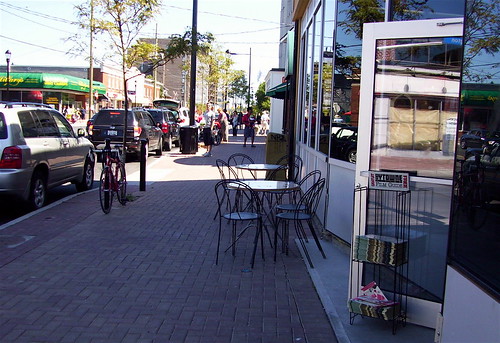
Placing a couple of tables and a few chairs on the sidewalk is a relatively innocuous use of public space. The absence of a railing or permanent patio and the obvious transitory nature of this use make it quite benign. In this sense, it is a simple and harmless way of enhancing the street and adding to the level of public interaction. However, without the appropriate permissions and fees, it is also an illegal encroachment of pedestrian access to sidewalk space, and an unfair commercial gain at the expense of public property. It is worth regulating this type of use?
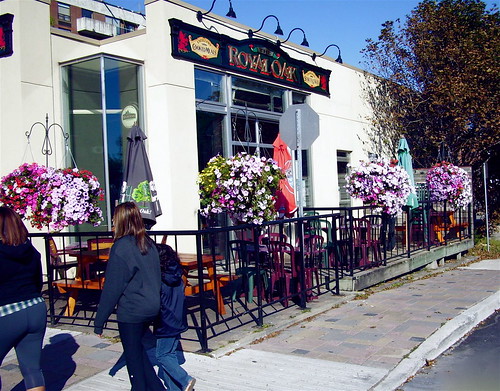
A classic patio, with the required railing and semi-permanent wooden deck built – at least in large part – on a public right of way. The owner may have “acquired” rights from the city to use this space, but a member of the public not interested in paying for a drink would not be welcome here, or, at a minimum, would not feel welcome. At the same time, the effect of a sidewalk patio makes for a more interesting and animated street-level experience. Is this a fair trade-off?
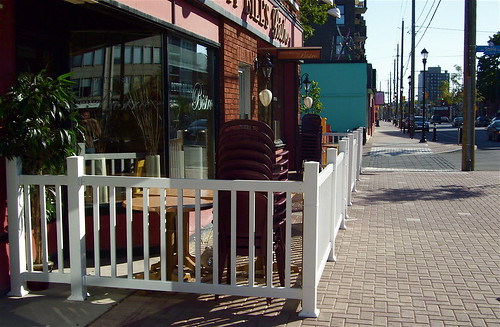
Some patios feel more like encroachments than others. Aesthetics matter. Regulating aesthetics is difficult, and has proven essentially impossible in Ottawa. If public space is to be used for private gain, then one contribution of a private business owner to the public space is in the form of aesthetics. This includes the material and colour of railing, and the type of chairs being used. These should be subject to public scrutiny if public space is at stake.
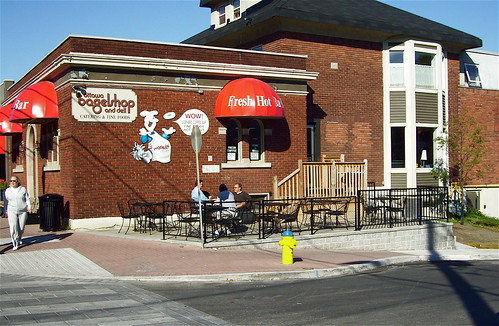
The construction of a more substantial and attractive patio can mean that public space has been enhanced. At the same time, the permanency of the construction suggests a more flagrant appropriation of public space for commercial gain.

A non-controversial scenario is where a commercial building is setback sufficiently so that an outdoor patio is located entirely on private property. If we planned our mainstreets for patios, this scenario would be more common. But then, part of the charm of Wellington Street West is its lack of uniformity.

There are also, of course, various instances of public use of public space. The addition of grass and trees has arguably enhanced this space. While the landscaping is inoffensive, the result is not particularly interesting or animated.
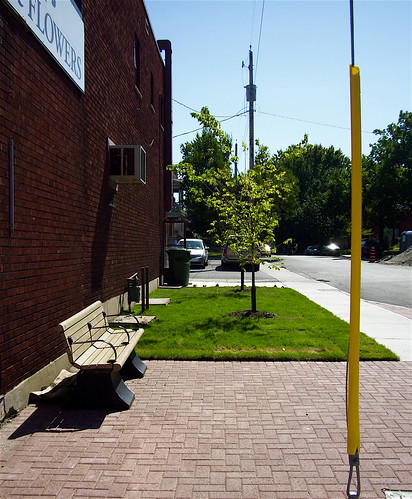
Formerly used as parking by the business owner/employees, trees and benches now animate this public space. Unless they are causing mischief, this space can be enjoyed by any member of the public at no charge. The seating is free. From a public space point of view, this is an improvement over its previous life.
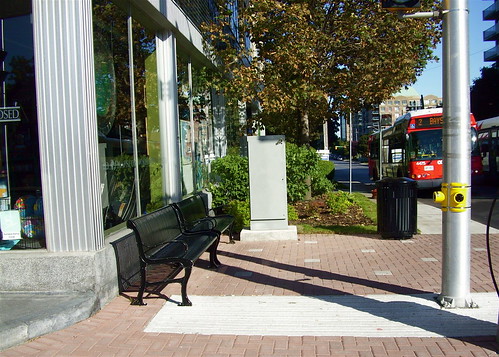
A street corner offering a bench and garbage bin seems like an appropriate and convenient respite for the weary pedestrian.
While each of the three previous photos offer examples of strict adherence to principle of public use of public space, the effect seems to be somewhat sterile. In this regard, there is clearly something to be said for allowing private use of public space.
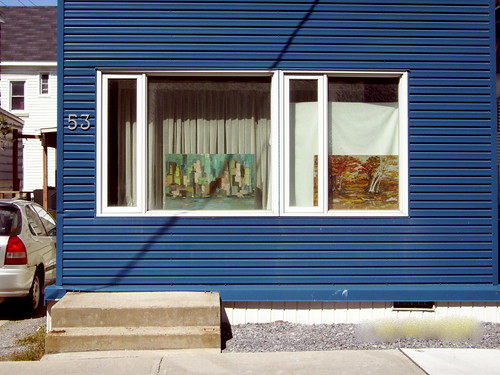
A far less common situation involves private property owners making their own space available for public gain. Flipping a painting so that passers-by can enjoy the artwork is a simple way of creating publicly-enjoyed private space, and displays a wonderful and unprovoked generosity of spirit.
As described by one City Councillor, City By-Laws regulating the use of public space by bars or restaurants are implemented in an ad hoc manner. This seems unavoidable. In the case of Wellington Street West, and countless other commercially-oriented mainstreets – there really is no simple way to regulate the relationship between public space and private use.
The tendency to apply existing bylaws in ways that can feel arbitrary or inconsistent is probably the most appropriate one. Navigating city life should be a little chaotic, nuanced, and unpredictable – that’s what makes cities and their neighbourhoods interesting and engaging. In the end, treating each case on its own merits (or demerits) with a mix of discretion, local knowledge, and mediation is the best course of action.
Wellington Street West is a 1.8 km mixed-use mainstreet situated west of Ottawa’s downtown core. The street runs through two distinct neighbourhoods, West Wellington and Hintonburg, and is the home of the Wellington West Business Improvement Area. Once the principal link connecting Ottawa’s west end to Parliament Hill, Wellington Street West is now disconnected from its well-known downtown name-sake and has taken on a unique character.

One comment
This article is a great assessment of sidewalk patios. Your discussion of various types of patios is what makes patios interesting: each is different. The best ones are those that plan the construction of buildings with the forethought of an outdoor commercial patio. However, most areas having commercial establishments that require encroachment into public space are some of the most walkable and attractive communities, such as Wellington Street West. Patios can be fenced, gated, covered with an awning, or simply a table with two shops.
As a land use planner, my immediate thought regarding patios is capacity. Of course, permission for additional seating area is part of a licensing protocol, but there’s the issue of pedestrian volumes on the sidewalk and parking. In some areas, four additional seats could necessitate one more parking space. However, in areas like Wellington West, it would probably necessitate a dozen seats for a single parking space under zoning by-law requirements. Of course, planning regulations permit payments of cash-in-lieu of parking in order for the City to maintain or improve existing public parking spaces and transit services. The issue of sidewalk capacity in pedestrian-oriented communities could be even more important. Maintaining appropriate widths depending on pedestrian volumes helps maintain the walkability of the area and blends the public and private realms.
Car-free days in Kensington Market in Toronto takes outdoor patios to the pleasant extreme (http://www.flickr.com/photos/15501706@N00/2631930907/). Outdoor patios extend off the property and occupy the entire sidewalk, since pedestrians have claimed the street as their right of way. The joy of people-watching is enriched tremendously in this situation.
Another great example is found on the Tay River in Perth, Ontario (http://www.flickr.com/photos/15501706@N00/2062762256/in/set-72157603404682449/). A wooden set of decks extend out from the side of a building over 1/4 the width of the channeled river. Patrons of the restaurant can enjoy summer weather while fish swim by and pedestrians on the bridge take pictures of the scene.
In a country like Canada where cold weather lasts through half the year, hopefully we’ll engage well conceived outdoor patios in our well established communities as added value.